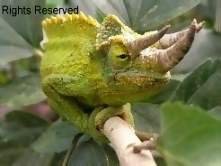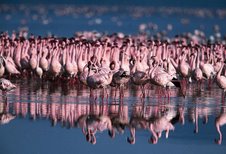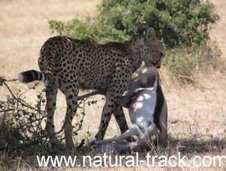Tsavo Cheetah Project (TCP) which was commenced in April 2011, by the
Principle Investigator, Cherie Schroff. The long-term project works in
affiliation with Felidae Conservation Fund and Kenya Wildlife Service
(KWS) under a research permit which covers the 40,000 km? Tsavo
Ecosystem, from the National Council of Science and Technology. TCP is
independently registered in Kenya as a national NGO. Prior to
implementation, the last scientific cheetah population assessment for
the Tsavo region was in 1990, when Paule Gros estimated cheetah numbers
in and surrounding Kenya?s protected areas. At a total estimate of 793
cheetahs, 55% was based in Tsavo (Gros 1998). The Tsavo cheetah
population along with connecting populations (Mara and Serengeti) makes
up one of two globally important cheetah populations in Kenya and one of
four in East Africa. The resident Tsavo cheetah population is part of a
larger trans-boundary population, where subpopulations in Tsavo,
Maasailand, and the Maasai Mara, connect through contiguous areas of
Tanzania. In addition to the significance of Tsavo to these connecting
populations, the Tsavo ecosystem is recognized as hosting a large and
significant cheetah population, in the country’s national strategic plan
for the species. This project supports multiple objectives, goals,
targets and activities, as outlined in the National Conservation and
Management Strategy for Cheetah and Wild dog (2010).
What they are doing:
The aim of TCP is to protect and conserve the Tsavo ecosystem cheetah
population with a multifaceted, holistic approach. As a long-term
project in Kenya, The Tsavo Cheetah Project monitors cheetahs for trend
and threat information on an ongoing basis. TCP employees standardized
cheetah monitoring techniques, including direct sightings, our tourists
and park staff assisted photographic survey, camera traps, and spoor
tracking. Within Tsavo East National Park, the project is also working
with KWS to combat off-road driving and cheetah harassment, which has
the potential to threaten the cheetah’s chances of survival through
behavior alteration.
Since its inception in mid-2011, the project has conducted interviews
with residents living on the periphery of the park to compile data on
cheetah sightings and conflict issues. We conduct verifications on
livestock predation and investigate reports on the retaliatory killing
of cheetahs. Education is a key component to cheetah conservation in the
Tsavo region. Therefore engaging communities on the proper
identification and differentiation between spotted cat species and
specific predator behavior, coupled with on-site assistance on livestock
husbandry improvement, are critical ongoing activities of TCP. All
field activities in Tsavo East will continue throughout the park and
adjacent land, eventually expanding with added staff throughout the
ecosystem to assess cheetah population threats and demographic trends
overtime.
What they Need & What You Get
The requested total amount of $5,000 is estimated to cover a three month
period (July ? September) in the field, including vehicle rental
pending award for vehicle purchase
? Vehicle hire / petrol / maintenance fees (only a few activities can
actually be done on foot; this is lion and elephant habitat, too, and a
vast area)
? Camp and sustenance (yes, we require food and shelter, on the lowest possible budget)
? Local assistant salary for cheetah education program implementation
(essential for cultural issues, language barriers and capacity building)
? ?A Tsavo Cheetah?s Ecosystem? educational materials for local schools
and community visits where conflict exists (it?s important to make it
fun, interesting and engaging for local children and adult residents).
If any donor wants these costs broken down to monthly / weekly / daily
amounts and the estimation for booklets and poster materials, please
contact me. Receipts in Kenyan shillings can also be provided to donors
What you get:
$25: Acknowledgement on the project website and social media pages.
$100: Acknowledgement on the project website and social media, and a
private photograph of a newly identified Tsavo cheetah, during 2013.
$1000: Acknowledgement on the project website and social media, and two
private photographs of newly identified Tsavo cheetahs, during 2013.
$2,000: Three day period with the project in the field (covers a daily /
packed or locally bought lunch and transportation for two in the
project vehicle during daily field activities for a 3 day period-dawn to
dusk!).
$5,000: Seven day period with the project in the field (covers a daily /
packed or locally bought lunch and transportation for two in the
project vehicle during daily field activities for a 7 day period-dawn to
dusk!).
If anyone?s interest in exceeding this seven day time period for an additional donation, this is also possible!
The Impact
The best way that you can help save the cheetah, is to donate to
specific on-ground conservation projects, like ours, who have secured
the permits and partnerships to do the field work but only require
additional funding.
Grant awards do not last forever and rarely do they cover all field
costs, such as petrol and research assistant salary. There are often
time periods in between applications and awards when researchers and
conservationists in the field rely solely on in-kind donations and
fundraising. Critical project activities can only continue on a
consecutive basis, if funding is continuously flowing in?
Our community assistance and educational programs to reduce cheetah
conflict and persecution , cheetah ID and monitoring inside and outside
the Tsavos, should not be halted due to lack of petrol, camp, or vehicle
rental costs… Threats to these cheetahs do not decrease as project
funds do, unfortunately.
Please consider assisting in our research and conservation efforts
to save this critical Trans boundary population in East Africa.
PKP. Kenya safaris
Natural Track Safaris
Monday, May 27, 2013
Subscribe to:
Comments (Atom)








